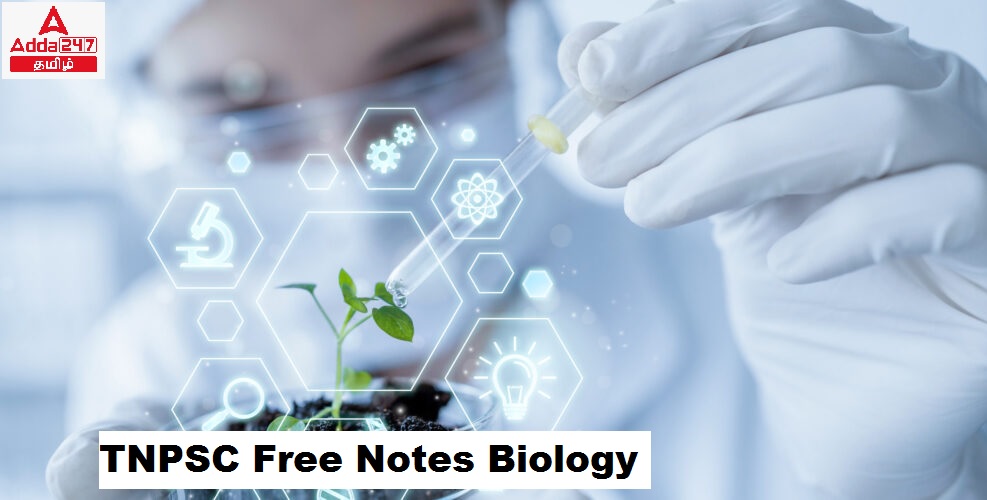இந்தக் கட்டுரையில், TNPSC குரூப் 1, குரூப் 2, குரூப் 2A, குரூப் 4 மாநிலப் போட்டித் தேர்வுகளான TNUSRB, TRB, TET, TNEB போன்றவற்றுக்கான முறைகள் இலவசக் குறிப்புகளைப் பெறுவீர்கள்.தேர்வுக்கு தயாராவோர் இங்குள்ள பாடக்குறிப்புகளை படித்து பயன்பெற வாழ்த்துகிறோம்.
Human Endocrine Glands
Exocrine glands and endocrine glands are two kinds of glands found in
animals.
Thomas Addison is known as Father of Endocrinology.
English physiologists W. M. Bayliss and E. H. Starling introduced the
term hormone in 1909.
They first discovered the hormone secretin.
The branch of biology which deals with the study of the endocrine glands
and its physiology is known as ‘Endocrinology’.
These glands are called ductless glands.
Their secretions are called hormones which are produced in minute
quantities.
The secretions diffuse into the blood stream and are carried to the distant
parts of the body.
They act on specific organs which are referred as target organs.
Hormones are chemical messengers because they act as organic catalysts
and coenzymes to perform specific functions in the target organs.
The target organs contain receptor molecules either on the surface or within
the cell.
Serious deficiency or excess secretion of hormones leads to disorders.
Hormones coordinate different physical, physiological, mental activities and
maintain homeostasis.
Hormones are composed of water soluble proteins or peptides or amines or
fat soluble steroids.
The hormones circulate around the body and eventually reach the target
Organs.
Endocrine glands include the pituitary, thyroid, parathyroid, pineal,
adrenal, thymus and are also known as exclusive endocrine glands.
The hypothalamus along with its neural function also produces hormones
and is considered as a neuro endocrine gland.
In addition several organs such as pancreas, gastro intestinal tract
epithelium, kidney, heart, gonads and placenta also have endocrine tissues
and are known as partial endocrine glands.
Exocrine glands have specific ducts to carry their secretions e.g. salivary
glands, mammary glands, sweat glands.
Endocrine glands present in human and other vertebrates are
1. Pituitary gland
2. Thyroid gland
3. Parathyroid gland
4. Pancreas (Islets of Langerhans)
5. Adrenal gland (Adrenal cortex and Adrenal medulla)
6. Gonads(Testes and Ovary)
7. Thymus gland
Pituitary Gland
The pituitary gland (means to grow under) is pea shaped and is located in
the Sella turcica, a bony cavity of the sphenoid bone at the base of brain
and connected to the hypothalamic region of the brain by a stalk called
infundibulum.
They are the anterior lobe (adenohypophysis) and the posterior lobe
(neurohypophysis).
The anterior lobe originates from the embryonic invagination of
pharyngeal epithelium called Rathke’s pouch and the posterior lobe is
originates from the base of the brain as an outgrowth of hypothalamus.
Anatomically the adenohypophysis has three lobes or zones namely pars
intermedia, pars distalis and pars tuberalis.
The neurohypophysis is otherwise known as pars nervosa.
The pituitary gland forms the major endocrine gland in most vertebrates. It
regulates and controls other endocrine glands and so is called as the
“Master gland”.
Hormones secreted by the anterior lobe (Adenohypophysis) of pituitary
The hormones secreted by anterior pituitary are
A. Growth Hormone
B. Thyroid stimulating Hormone
C. Adrenocorticotropic Hormone
D. Gonadotropic Hormone which comprises the Follicle Stimulating
Hormone and Luteinizing Hormone
E. Prolactin
A. Growth hormone (GH)
GH promotes the development and enlargement of all tissues of the body.
It stimulates the growth of muscles, cartilage and long bones.
It controls the cell metabolism.
The improper secretion of this hormone leads to the following conditions.
1. Gigantism
2. Dwarfism
3. Acromegaly
B. Thyroid stimulating hormone (TSH)
TSH controls the growth of thyroid gland, coordinates its activities and
hormone secretion.
C. Adrenocorticotropic hormone (ACTH)
ACTH stimulates adrenal cortex of the adrenal gland for the production of
its hormones.
It also influences protein synthesis in the adrenal cortex.
D. Gonadotropic hormones (GTH)
1. Follicle stimulating hormone
2. Luteinizing hormone which are essential for the normal development of
gonads.
1. Follicle stimulating hormone (FSH)
In male, it stimulates the germinal epithelium of testes for formation of
sperms. In female it initiates the growth of ovarian follicles and its
development in ovary.
2. Luteinizing hormone (LH)
In male, it promotes the Leydig cells of the testes to secrete male sex
hormone testosterone.
In female, it causes ovulation (rupture of mature graafian follicle),
responsible for the development of corpus luteum and production of
female sex hormones estrogen and progesterone.
E. Prolactin (PRL)
PRL is also called lactogenic hormone.
This hormone initiates development of mammary glands during
pregnancy and stimulates the production of milk after child birth.
Hormones secreted by the posterior lobe (Neurohypophysis) of pituitary
1. Vasopressin or Antidiuretic hormone
2. Oxytocin
1. Vasopressin or Antidiuretic hormone (ADH)
In kidney tubules it increases reabsorption of water.
It reduces loss of water through urine and hence the name antidiuretic
hormone.
Deficiency of ADH reduces reabsorption of water and causes an increase in
urine output (polyuria).
This deficiency disorder is called Diabetes insipidus.
2. Oxytocin
It helps in the contraction of the smooth muscles of uterus at the time of
child birth and milk ejection from the mammary gland after child birth.
**************************************************************************
| Adda247 TamilNadu Home page | Click here |
| Official Website=Adda247 | Click here |




